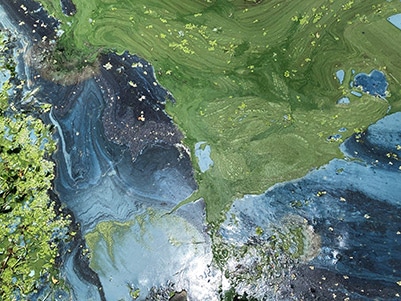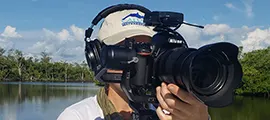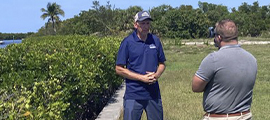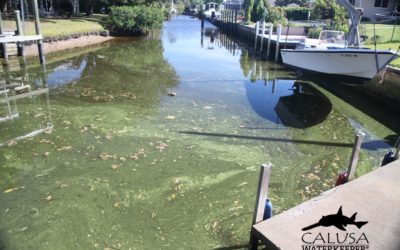Issue:
Harmful Algal Blooms

Blue-green Algae (Cyanobacteria)
Cyanobacteria is one of the oldest types of lifeforms on Earth and is found primarily in freshwater systems. There are thousands of species of cyanobacteria and many are known to produce a variety of toxins.
Cyanobacteria is a photosynthetic microorganism that processes sunlight, nitrogen and phosphorous to live. They can regualate their position in the water column for optimal light and thrive in warm, nutrient-rich fresh or brackish water with low turbulence.
Microcystis and Anabaena are two of the most common cyanobacteria found in estuarine systems today. These bacteria are known to produce cyanotoxins dangerous to humans and animals. Microcystin and Anatoxin are classes of hepatoxin and neurotoxin, affecting the liver and brain, respectively.
Human and animal exposure to Cyantoxins comes in three primary forms of contact:
- Dermal contact
- Inhalation or aspiration from aerosolized surface water
- Ingestion
Harmful algal blooms have severe impacts on human health, aquatic ecosystems and our economy.
Red Tide (Karenia brevis)
Red tide is a marine dinoflagellate found in saltwater, and has been known to inhabit the Gulf of Mexico throughout recorded history. Red tide blooms have been increasing in scope and intensity within the last 30 years. Red tide has also occurred throughout the Gulf and Atlantic Coast, reaching as far as North Carolina.
Karenia brevis can utilize at least 12 different forms of nutrients and also consume other single cell organisms for food. They are capable of motion and directed swimming allowing them greater access to nutrients.
Red Tide produces brevatoxins which can be deadly to many sea animals and often causes acute respiratory symptoms in humans. Aerosolized health effects include irritation of the eyes, nose, throat and lungs and exacerbating occurrences of respiratory distress, bronchitis, asthma and pneumonia. Brevatoxin can also have a serious impact on the marine food-chain, contributing to shellfish poisoning and gastrointestinal disorders.

Take Action
Contact Your State Legislators
Calusa Waterkeeper calls on citizens and stakeholders to urge elected officials and responsible agencies to take the following ten actions:
The toxic blue-green algae (cyanobacteria) often stretching from Lake Okeechobee to our west coast is the result of decades of failed water policy implementation. A perfect storm of lax enforcement and under-funding at the local, state and national levels has culminated in the historic harmful algae blooms (HABs) that plagued our region in 2018 (and so many other years).
If political leaders fail to take action, history is doomed to repeat itself year after year, causing catastrophic harm to our ecosystem and our economy.
The science is clear on what needs to be done.
What has been lacking is the political will to enact the regulation and legislation required to begin to reverse these problems. We look to you, as informed citizens, to proactively communicate your water quality concerns to newly elected officials. It will take a groundswell of voices if we are to affect change in Tallahassee during this coming legislative session.
Find Your Legislators
Related News Stories
Harmful Algal Blooms
Implementation of Governor DeSantis’ Blue-Green Algae Task Force Recommendations Act – SB 1522 / HB 1225
The current bill language for SB 1522 has lost or is missing several key recommendations of the Blue-Green Algae Task Force. It’s imperative that the legislature act now, as yet another major blue-green algae bloom has formed on Lake Okeechobee and other areas of the state.
A Win Against the Army Corps’ Toxic Lake Okeechobee Discharges
Federal Judge orders the U.S. Corps of Engineers to consider toxic algae when releasing water from Lake Okeechobee. Fort Myers, FL: Calusa Waterkeeper is proud to be involved with a recent win in federal court regarding the management of Lake Okeechobee and its impacts to the Caloosahatchee and St. Lucie estuaries.
Poison Blooms
Florida’s waters are at a tipping point as phosphorus and nitrogen pollution and climate change combine to create a perfect storm for the increasingly frequent outbreaks of toxic blue-green algae and red tides. St. Johns Riverkeeper Lisa Rinaman and Calusa Waterkeeper John Cassani are leading the fight against this growing scourge.
Florida Department of Health Fails to Consistently Notify Residents of Health Risks from Toxic Blue-Green Algae
After massive and recurring blue-green algae blooms in Florida waters that resulted in multiple “states of emergency” issued by then-Governor Rick Scott in 2016 and 2018, the Florida Department of Health (FDOH) is still unable to consistently warn the public of the toxic blooms.
Blue-Green Algae Returns to Fort Myers Shores
John Cassani said to see algae in the middle of the dry season is unusual. ”When it’s calm and the wind starts blowing, those tend to stick together,” Cassani said. “Then they produce polysaccharide that enables them to kind of glue together and forms those mats.” Cassani is talking about big green chunks seen in canals in 2018.
Health Department will Post Warning Signs for Blue-Green Algae Spotted in Calossahatchee
Just in time for the height of tourist season, patchy slicks of blue-green algae are showing up in the Caloosahatchee, including at one of the river’s popular access points, the Davis Boat Ramp. Although users launching boats and watercraft at the ramp saw no warning signs about the potential dangers of contact cyanobacteria.
Make a Donation
Get Notified
Priority Issues
Harmful Algal Blooms
Cyanobacteria & Red Tide
Cyanobacteria (blue-green algae) and Karenia brevis (red tide) have been making major impacts on Southwest Florida.
Lake Okeechobee Discharges
Revise System Operating Manual
The Caloosahatchee River often suffers from too much freshwater in the wet season, and not enough freshwater in the dry season.
Cape Coral Spreader Canals
Nutrient & Sediment Loading
The City of Cape Coral is working to remove large storm-water barriers to make recreational boating more convenient.
Bacteria Monitoring
Fecal Indicator Bacteria
Calusa Waterkeeper has been at the forefront of monitoring this Fort Myers tributary for fecal bacteria indicators.




































